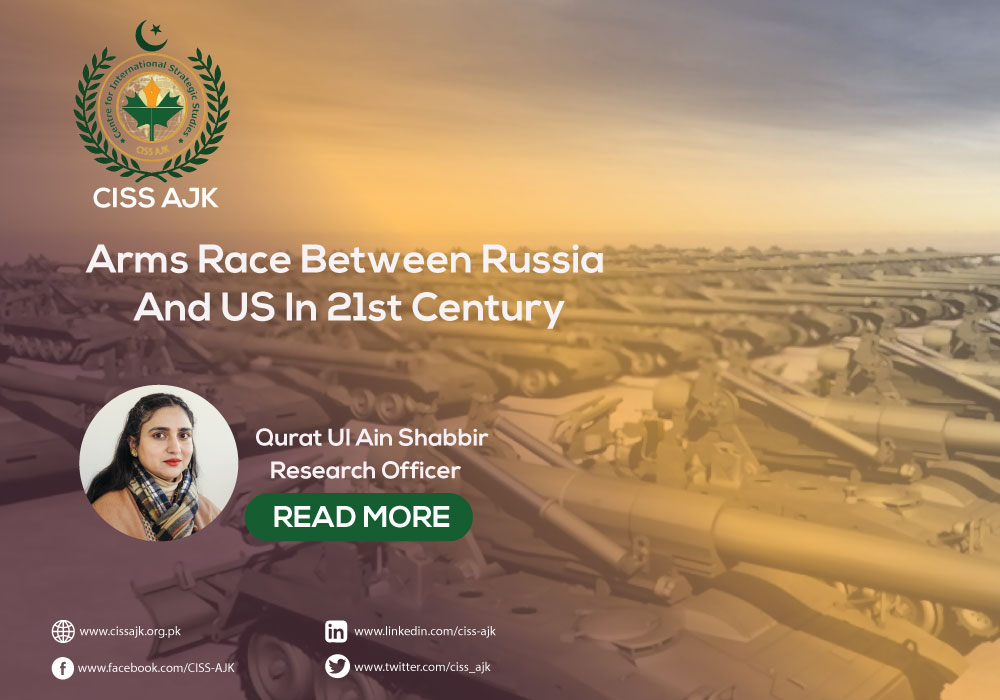573
The future of the final remaining arms control agreement between the two biggest nuclear powers in the world is uncertain after Russian President Vladimir Putin declared on 21st February 2023 that Russia would stop its participation in the New START agreement with the US. The United States had already announced its withdrawal from Intermediate-Range Nuclear forces (INF) treaty in 2019 citing Russia’s non-compliance with the treaty as a reason. This announcement had resurfaced the concerns that a new arms race might have started, causing a sense of Cold war déjà vu. With the demise of INF treaty, another arms control treaty New START is also in shambles. The major arms control efforts that took decades to realize are in chaos and so is world’s strategic stability. The United States and Russia are both taking up modernization programs to rebuild and refinance their nuclear forces. Russia continues to have stockpile of thousands of nuclear warheads, more than 1,500 nuclear weapons that can be deployed on missiles and bombers are capable of reaching territory of United States. Meanwhile US has also extended the life of its Ohio-class submarines by refueling their reactor cores. It has also planned to build new military systems from the late 2020s. Both countries view these developments with suspicions and consider them a potential threat to their security and survival. Thus, exist a security Dilemma which can trigger potential arms race between these two countries.
Maintaining strategic stability has been the agenda of foreign and defense policies of both US and Russia since the end of the cold war. Arms reductions specifically nuclear weapons has been given special attention in their bilateral relations. This also explains the agenda of New START treaty. In the last decade, however, Russia has strengthened its military capabilities many folds. It has also adopted aggressive foreign policy and US-Russian bilateral relationship has gone bitter once again. Developments in the last two decades such as Russian invasion of Ukraine and Georgia, interference in Syrian civil war, NATO’s expansion of its military capabilities and Russian overall military interference in Europe has raised tensions between the former Cold War rivals. All these developments were then followed by US announcement of its withdrawal from INF treaty on 2nd August 2019 citing reason that it undermines US strategic interests given Sino-Russian strategic partnership and Russian military activities in Europe. Russia denied US claims and accused Washington of withdrawing because it wants to pursue a new arms race.
After US withdrawal from INF treaty the only arms control treaty between the US and Russia remains is NEW START which put a limit on both countries for not exceeding the number of nuclear war heads beyond 1550.
Before sabotaging last remaining arms control treaty, policy makers in Moscow and Washington should keep in mind the ramifications of US withdrawal from INF treaty and Russian deployment of Novator 9M729. Such developments could possibly trigger development of new INF missiles not just in Russia and US, but many other countries can follow the suit. US, Russia along with European NATO allies should really ponder what other alternative means they have to tackle such proliferations of arms?
Europe in coming years might face another missiles deployment debate and there are chances that there will be building ups of missiles in both Russia and NATO countries. Such scenario will put negative impact on the strategic stability of the entire world. The emerging situation indicates that world is moving back at the 1970s. Both countries have come to full circle after years of dialogues on arms control.
The strategic environment from 2010s have changed, with North Korea’s nuclear provocations, Sino-Russian bilateral strategic cooperation and arms trade, Russia modernizing its weapons and carrying out military activities with its conventional forces, and US nuclear posture review of 2018 in which Secretary of Defence James Mattis outlines the threats US faces from other nuclear powers and the policies to maintain strategic stability of US.
All these notable developments in the last decade have put great pressure on nuclear world order. Such strategic environment will likely increase the number of nuclear warheads around the world. It will also exacerbate the mistrust among countries most notably between Russia and US.
This emerging power dynamics would also impact countries aligned or allied with US and Russia. Policy makers should assess whether US and Russia can develop a framework for non-treaty options which both countries can mitigate in order to develop a working relation while keeping in focus what kind of threat perception both US and Russia hold against each other? Threat perceptions are based on each country’s own understanding of reality which usually originate from past experiences, lack of trust and clash of strategic interests. Apart from this, both US and Russia should figure out incentives or mutual interests in forging a bilateral cooperation in foreseeable future for the sake of maintain strategic stability. There is a dire need to divulge potential options for US-Russia working relationship while assessing limitations and risks linked with each option.

